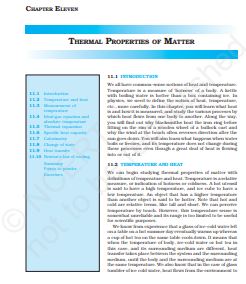‘NCERT Solutions for Class 11 Physics Chapter 11′ PDF Quick download link is given at the bottom of this article. You can see the PDF demo, size of the PDF, page numbers, and direct download Free PDF of ‘Ncert Class 11 Physics Chapter 11 Exercise Solution’ using the download button.
NCERT Class 11 Physics Textbook Chapter 11 With Answer PDF Free Download

Chapter 11: Thermal Properties of Matter
Our everyday notions of hot and cold are related to the temperature of an object. We consider a boiling kettle to be hotter than ice – it’s just common sense. But in physics, to accurately study how heat moves between things we need clear definitions.
This chapter will look at what heat is, how it flows, and what causes interesting processes like boiling water or melting ice. You will learn some clear examples such as why blacksmiths heat iron rings before placing them on wooden cart wheels. Once you understand the physics it makes sense! Or have you noticed how beach winds often change direction at night? This is also due to heat transfer.
Temperature indicates whether something is hotter or colder than something else. Too subjective concepts for science! A thermometer measures temperature based on how heat causes a material to expand or contract. We are accustomed to making liquid thermometers in glass using mercury or alcohol.
Understanding heat and temperature allows us to interpret real-world observations. Just as in the summer heat, a cold drink becomes hot, but hot tea becomes cold. It’s all about how heat moves between objects until they reach the same temperature. pretty neat!
With clear physics definitions, we can study the details of heat transfer quantitatively. That understanding powers real technology, from engines to weather forecasting. Heat plays out in fascinating ways in both daily life and cutting-edge science. let’s explore!
| Author | NCERT |
| Language | English |
| No. of Pages | 24 |
| PDF Size | 1365 KB |
| Category | Physics |
| Source/Credits | ncert.nic.in |
NCERT Solutions Class 11 Physics Chapter 11 Thermal Properties of Matter
Thermal Properties of Matter Textbook With Solutions PDF Free Download
